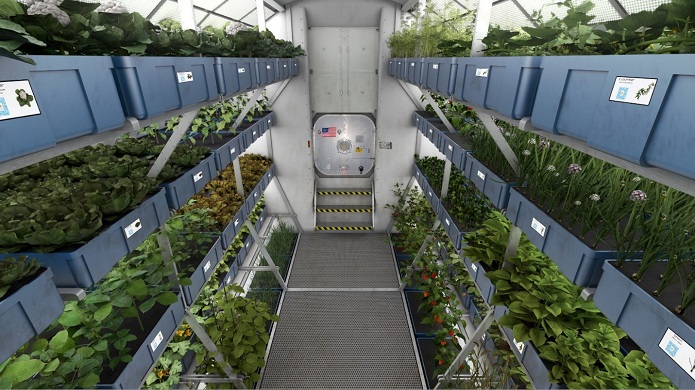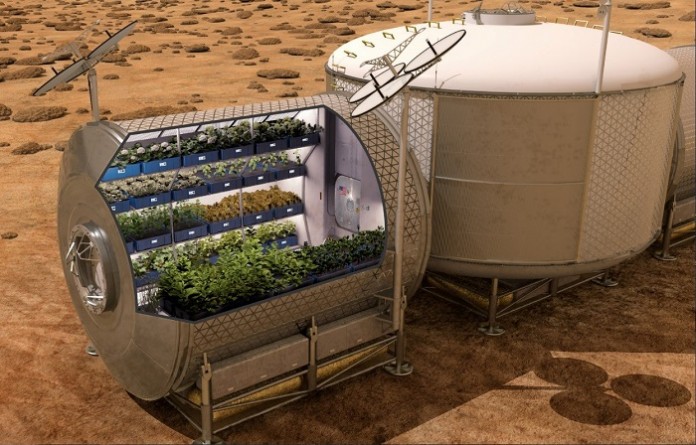Inside the research lab module, bright LEDs on the multi-shelved hydroponic system turn on and off in harmony. Smiling at the automated efficiency of the system, you carefully consider when to thin out the lettuce seedlings and when to harvest the radishes, tomatoes and peppers. Last stop, the attached plant growth module, which is connected to the central node.

The plant module has large crops that have filled the module to where it almost looks like a jungle surrounding the central aisle. Now that the morning duties are complete, it is time for a good strong cup of coffee and some breakfast potatoes fresh from the garden. At moments like this, it feels more like home.
NASA is on a journey to Mars. Every day, NASA is working to develop new technologies and find innovative solutions to challenges facing aeronautics, space exploration and the greater scientific community. One of the greatest challenges is in-situ resources. Mining resources to make oxygen, nitrogen, methane as well as the growth of a self-sufficient food supply is critical to make this journey safer and more cost effective.
Hab Garden Racks will be made up of multi-shelved hydroponic systems. This system is managed autonomously. It checks the water level in the circulation reservoir; if low, it will add enough water from the heat exchange condensing unit to bring it back up to the mark. Second, it checks the nutrient solution and the pH control. Third, it monitors the “garden” temperature, humidity, carbon dioxide and other hydroponic system parameters and displays them on a computer screen for the astronauts to periodically review for trends. Lastly, a look at the plants. Even with all of the automation, astronauts will still be required to support the harvest. With all the automated controls, the process only take about 15 minutes. But for harvests and plantings, it will probably take at least an hour out of the day.
An attached plant growth module may provide 20 square meters of growing area or more. This would be connected to the central node module and operated at cabin pressure; however, with its hatch and air lock, it could be run at reduced pressures if needed. Studies by Japanese, European, US and Canadian researchers showed that plants grow just fine down to ¼ of an atmosphere (25 kPa), so long as the oxygen, carbon dioxide and water vapor partial pressures are maintained properly. The large plant growth module has LED lighting just like the smaller Hab Garden Rack. But instead of only 40 centimeter shelves, the plant module has large crops filling the module, which is good because it means you are wasting very little light that is driving energy for producing the food and oxygen in photosynthesis. In addition to the LED lighting, supplemental sunlight being collected by the external solar concentrators is focused into the module through fiber optic bundles.
In the module, water filling is automated. About ¾ of the module is likely hydroponic and a small 5 square meter plot is testing the use of Martian regolith as a rooting bed. The air is humid and circulating around all of the different crops; designed temperature gradients form, supporting the cooler needs of potatoes and strawberries, while a warmer zone blankets the wheat, soybean, rice and sweet potatoes. This is where a great design and an almost artistic touch is required to create the “cross-gradient” temperature control for the multiple crops. In early stages, astronauts will still be required to check the drying wheat heads to determine the number of days until harvest time. Soon after, threshing units and dust control systems are set up, wheat heads processed, and then leaves and stems are placed into the composter for eventual incorporation with regolith experiment beds. It will be interesting to see how the new, high nitrate regolith and incorporated compost will effect growth of the plants. A planned benefit of this system is that if the electrolytic oxygen production system goes off line unexpectedly, you have the green plants to help save on using the compressed oxygen reserves. If future missions continue, additional logistics modules could be added after the supplies are emptied out, which will expand the plant growth capabilities significantly. This could provide enough oxygen for a few of the crew members, and dietary calories as well. It will be exciting to see a small spot on the red Martian landscape slowly going green!
Last Updated: Feb. 24, 2016
Editor: William Bryan
Tags: Technology
Source: NASA
Image credit: NASA


